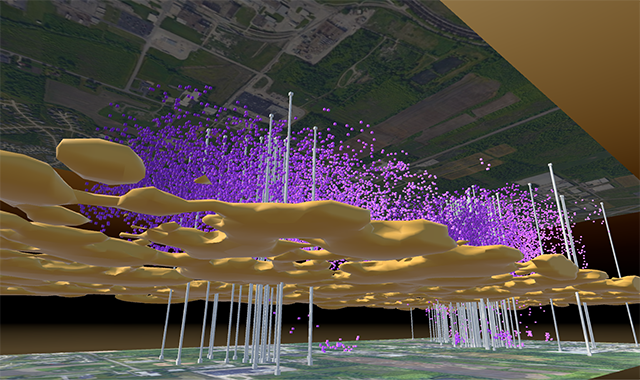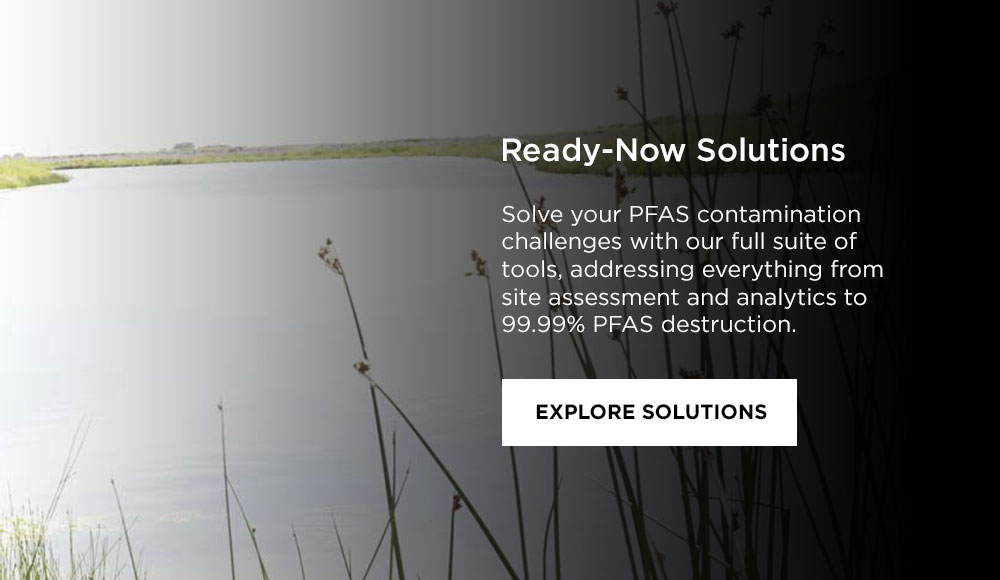Modeling the Movement of PFAS Plumes in Groundwater

Per- and polyfluoroalkyl substances (PFAS) are notoriously hard to monitor and remediate. Battelle's PFAS Predict™ technology will give military bases a new tool to track and predict the movement of PFAS chemicals in groundwater.
Responding to PFAS Contamination on Military Bases
PFAS is a class of man-made chemicals used in a broad range of consumer and industrial goods, including non-stick cookware, stain-repellent fabrics and construction materials. For many military bases, the biggest source of contamination is a class of discontinued firefighting foams known as Aqueous Film-Forming Foams (AFFFs). While these foams are no longer manufactured in the U.S., their legacy persists at bases around the country.
PFAS has been found in groundwater and drinking water near a number of military sites used for firefighting training exercises or storage of AFFFs, as well as sites with a history of crashes and fires. Growing public awareness of the health risks of PFAS and recent reports of drinking water contamination have made PFAS mitigation a priority at many military bases.
However, verifying the source of PFAS contaminants and predicting the spread of PFAS plumes can be difficult. PFAS chemicals are highly mobile and persistent in the environment, and they tend to move and spread differently than well-understood contaminants like petroleum hydrocarbons or volatile organic compounds (VOCs). There are more than 4,000 distinct PFAS chemicals in use, each with unique fate and transport properties. In addition, PFAS is often comingled with other contaminants, such as hydrocarbons at a fire site.
To respond effectively to known or suspected PFAS contamination, military engineers need clear answers. What is the probable source of the contamination? Are there multiple potential sources? Where is the PFAS plume moving, and at what rate? Does it present a risk to human health and the environment? And what is the predicted impact of different mitigation scenarios?

A Groundwater Transport Model Tailored for PFAS
Battelle created the PFAS Predict modeling tool to help military engineers answer these critical questions. It's designed to simulate PFAS fate and transport in groundwater and has specific inputs for per- and polyfluoroalkyl chemicals typically found in groundwater, aquifer properties and source release terms related to PFAS.
It can be used for:
-
Risk evaluation: The model predicts how the PFAS plume is likely to move through groundwater and allows evaluators to determine whether specific wells or groundwater receptors likely to be at risk as the plume migrates.
-
Remediation system design: System designers can simulate pump-and-treat operations and predict how the plume will respond to the treatment.
-
Source verification: The model allows backward tracking of plumes to determine the likely source(s) of contamination and enable apportionment of responsibility for plumes with multiple sources.
The PFAS Predict tool is different from similar modeling software because it focuses on the unique mobility of PFAS in groundwater. The program has options to scale dispersion processes based on observed PFAS groundwater plumes. The model simulates advection, degradation, diffusion, sorption and source release options. It is compatible with industry-standard MODFLOW groundwater models for remediation system design.
Our technology has been validated using site data from a military base for total PFOA and PFOS (the PFAS chemicals most widely used in AFFFs). These validation exercises showed that the unique processes included in the PFAS Predict model are particularly suitable for simulating PFAS behavior in groundwater. Battelle is currently seeking more validation opportunities at additional military sites.
Developing Tools for More Effective PFAS Response
The new modeling tool could help the military, industry and local communities respond to a significant environmental challenge. PFAS chemicals have been widely used in thousands of products and many industrial processes. Their widespread use and their mobility and persistence in the environment make source verification and remediation uniquely challenging. At the same time, public awareness and concern about PFAS have been growing, especially in relation to reports of drinking water contamination. As the health risks of PFAS become clearer, risk reduction for sites with existing PFAS plumes will be an urgent priority.
Battelle is continuing research and development to expand the use scenarios for the tool. We plan to further refine the groundwater model with additional monitoring data from other contaminated sites. Future models will provide an even better understanding of the behavior and movement of PFAS in the environment.
The PFAS Predict technology is part of a suite of tools and services Battelle has developed to help military and industrial clients respond to PFAS contamination. Battelle's analytical laboratory is accredited through the Department of Defense Environmental Laboratory Accreditation Program (ELAP) for PFAS analysis. Researchers at Battelle are working on novel methods to expand the range of PFAS analytes that can be detected and the matrices that can be tested. Battelle is also involved in PFAS remediation projects and toxicology studies.
PFAS contamination is a problem that the military and industry will face for many years to come. Better tools for PFAS analysis and modeling will enable scientists and engineers to make more effective decisions for monitoring and remediation programs.
About the Author
Joel Sminchak is a hydrogeologist at Battelle with 22 years of experience in environmental investigations, groundwater modeling, subsurface characterization, geotechnical analysis, and carbon storage. His technical research has focused on groundwater monitoring, geologic carbon storage, subsurface characterization, greenhouse gas emissions life cycle analysis, geologic hazard analysis, reservoir monitoring, and subsurface resource management.
BATTELLE UPDATES
Receive updates from Battelle for an all-access pass to the incredible work of Battelle researchers.